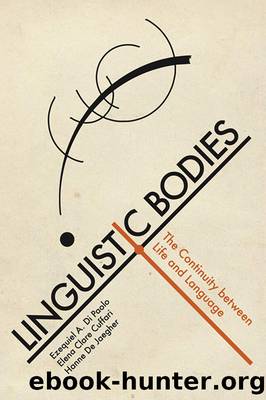Linguistic Bodies by unknow

Author:unknow
Language: eng
Format: epub
Tags: enactivism; embodiment; life-mind continuity; theory of bodies; primordial tension; personal selfhood; constitutive theory of language
ISBN: 9780262038164
Publisher: MIT Press
Published: 2018-10-25T00:00:00+00:00
Sensorimotor and organic bodies are transformed under the socially mediated and reflexive relations linguistic agents enter into to the point of becoming dependent on linguistic skills, broadly construed. Planning and executing complex sensorimotor sequences, organizing memory, using tools, querying experience, and controlling attention are all, in the human case, linguistically organized and regulated. It is telling just how much of a stretch of the imagination is required for the vast majority of us to envision life without language. Breathing is arguably achievable without linguistic mediation, yet it can be regulated by it as in yoga, or controlled practice for swimming or running, or in military training. Eating, securing shelter, caring for illness and injury, managing the care of others, and so on are not typically lived at the human level without language.
With linguistic bodiesâsuch is their constitutive blend, weaving the social and the personalâa new form of autonomy emerges at the community level, that of patterns of utterances, expressions, styles, and open-ended norms. This emergence can be explained partly on the model of the habitus, partly on the thematizing powers of dialogically empowered criticism that promotes social changes in the form of struggles. This new form of social autonomy, the linguistic community, is not only a domain of ways of interacting, but in general of organizing practices and producing subjectivities. It is also a realm where the sense-making of linguistic participants is evaluated and reshaped at all levels in accordance with emerging linguistic normsâthat is, norms pertaining to the ongoing individuation of linguistic bodies.
We summarize the second part of the dialectical model in figure 8.3. As can be appreciated, the concepts of linguistic bodies and linguistic communities are not themselves resolutions to the tensions that emerge in the last stage of the model but ways these tensions are manifested and inhabited. The open-endedness, powers, and creativity of linguistic bodies derive precisely from their unfinished, self-contradictory nature, a theme to which we will return.
Figure 8.3âSummary of the second part of the dialectical model. The diagram continues from the end of the diagram shown in figure 7.2 (first part of the model).
Download
This site does not store any files on its server. We only index and link to content provided by other sites. Please contact the content providers to delete copyright contents if any and email us, we'll remove relevant links or contents immediately.
Professional Troublemaker by Luvvie Ajayi Jones(28962)
Whiskey Words & a Shovel I by r.h. Sin(18833)
Rewire Your Anxious Brain by Catherine M. Pittman(17584)
Healthy Aging For Dummies by Brent Agin & Sharon Perkins RN(16608)
Cat's cradle by Kurt Vonnegut(13862)
Talking to Strangers by Malcolm Gladwell(11874)
The Art of Thinking Clearly by Rolf Dobelli(8839)
They Both Die at the End by Adam Silvera(8609)
Doing It: Let's Talk About Sex... by Hannah Witton(8547)
The 5 Love Languages: The Secret to Love That Lasts by Gary Chapman(8490)
Thirteen Reasons Why by Jay Asher(7785)
Wonder by R.J. Palacio(7729)
Goodbye, Things by Fumio Sasaki(7724)
The Compound Effect by Darren Hardy(7552)
Atomic Habits: Tiny Changes, Remarkable Results by James Clear(7208)
Becoming Supernatural by Dr. Joe Dispenza(7102)
Wonder by R. J. Palacio(7055)
Tools of Titans by Timothy Ferriss(6944)
Should I Stay or Should I Go? by Ramani Durvasula(6784)
